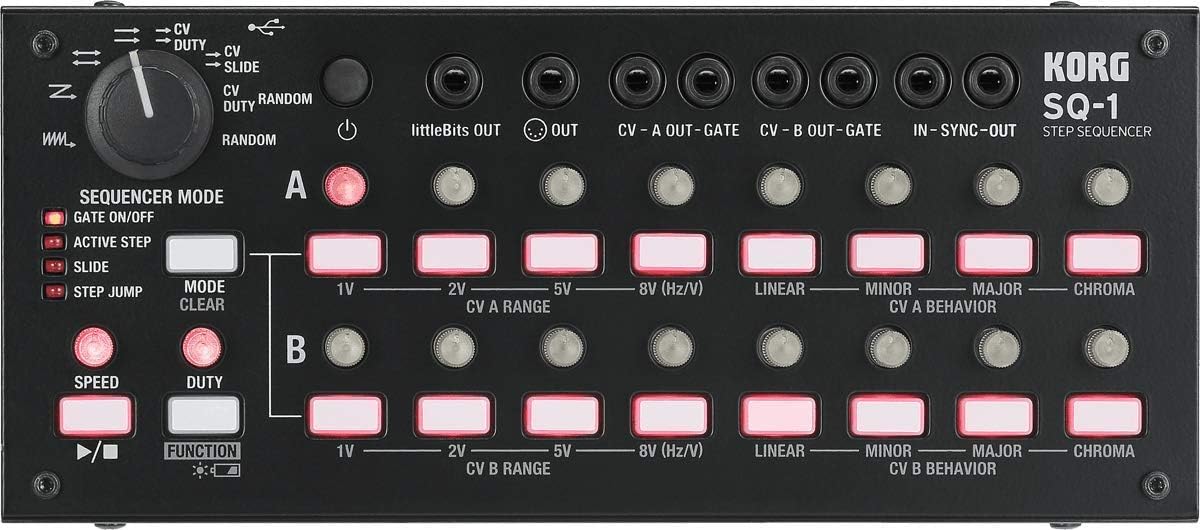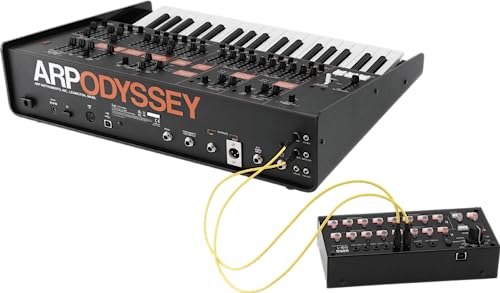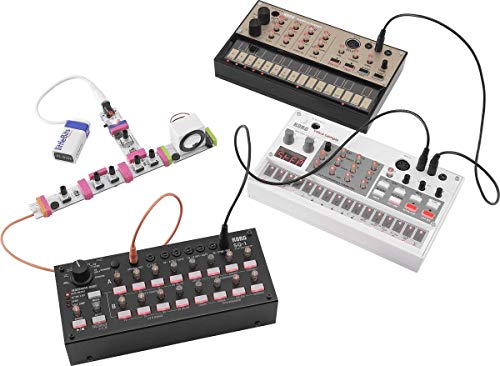
€107.40
Korg CV Sequencer And Sync Box SQ1 Price comparison
Korg CV Sequencer And Sync Box SQ1 Price History
Korg CV Sequencer And Sync Box SQ1 Description
Korg CV Sequencer And Sync Box SQ1: Elevate Your Music Production
The **Korg CV Sequencer And Sync Box SQ1** is a compact and versatile tool designed to enhance your music production setup. Whether you’re a seasoned pro or a beginner, this sequencer offers an intuitive way to manage your sounds in real-time. With its sleek design and powerful features, the SQ1 is a must-have for anyone looking to expand their synthetic experience.
Key Features and Benefits of the Korg SQ1
- Versatile Connectivity: With SYNC IN/OUT, CV OUT, GATE OUT, and MIDI IN/OUT connectors, it easily integrates into your existing workflow.
- Compact and Portable Design: Weighing only 1.41 pounds and measuring 9.8 x 4.33 x 3.42 inches, this device is perfect for musicians on the go.
- Battery-Powered Convenience: It operates on 2 AA batteries (included), ensuring mobility and flexibility when performing or creating music.
- Glossy Finish: The stylish black finish not only looks good but also fits seamlessly into any studio aesthetic.
- Easy to Use: Users can effortlessly manipulate step sequences, making it ideal for live performance and studio recordings alike.
Price Comparison Across Different Suppliers
When it comes to purchasing the Korg CV Sequencer And Sync Box SQ1, it’s essential to find the best deal. Prices vary significantly across online platforms. Our comparison tool allows you to see prices from various retailers, ensuring you get the best value for your money. You can easily identify which supplier offers the lowest price, helping you save while enjoying this powerful sequencer.
6-Month Price History Trends
Looking at the 6-month price history chart for the Korg SQ1 reveals some interesting trends. We’ve seen a steady increase in the average price, indicating growing demand. However, during discount seasons, we’ve noted price drops that could provide great opportunities for savings. Keeping track of these trends ensures you make an informed buying decision.
Customer Reviews: What Users Are Saying
The Korg CV Sequencer SQ1 has received a variety of reviews that highlight both its strengths and weaknesses.
**Positives:**
– Many users praise its build quality and ease of use, specifically noting how quickly they could integrate it into their music production workflows.
– The ability to create complex sequences effortlessly has been a standout feature for many, thanks to its clear and user-friendly interface.
– The compact size allows for easy transport, making it a favorite among mobile musicians.
**Negatives:**
– Some users noted that the battery life could be better. Although the device operates efficiently, continuous use may drain batteries faster than expected.
– A few customers expressed a desire for additional features, such as more outputs or an improved display for better visibility during live performances.
Overall, the Korg SQ1 garners a positive reception, showcasing its effectiveness as a sequencer and sync box in various musical setups.
Explore Unboxing and Review Videos
For those who want a deeper insight into the capabilities of the Korg CV Sequencer And Sync Box SQ1, several unboxing and review videos are available on platforms like YouTube. These videos showcase the product in action, providing an excellent opportunity to see how it performs in a variety of scenarios. Watching these clips can greatly enhance your understanding of the product’s features and usability before making a purchase.
Why Choose the Korg CV Sequencer SQ1?
If you’re searching for a reliable sequencer that combines functionality and portability, the Korg CV Sequencer And Sync Box SQ1 is an excellent choice. With its powerful connectivity options, ease of use, and stylish design, it can adapt to any musician’s needs, whether in the studio or on stage. Plus, its compact nature makes it incredibly convenient for travel.
In conclusion, whether you’re an amateur or a professional, the Korg CV Sequencer SQ1 opens up new possibilities for your music creativity. The growing demand and popularity of this device speak volumes about its quality and reliability.
Compare Prices Now!
Don’t miss out on the chance to elevate your music production experience. Take advantage of our price comparison tool to find the best deal on the **Korg CV Sequencer And Sync Box SQ1** today!
Korg CV Sequencer And Sync Box SQ1 Specification
Specification: Korg CV Sequencer And Sync Box SQ1
|
Korg CV Sequencer And Sync Box SQ1 Reviews (8)
8 reviews for Korg CV Sequencer And Sync Box SQ1
Only logged in customers who have purchased this product may leave a review.












Loddfaffnir –
I’ve used an SQ-1 for a while now, and I’ve just ordered a second. My son already has three of them. And we use them far more than any other sequencers. But I wouldn’t be likely to use them for live gigs – for that I’d go for something like my Beatstep Pro for the ability to reproduce (multiple) full arrangements on cue. The SQ-1 can’t do that, and it is quite fiddly – it’s almost impossible to dial in exactly the notes you want in a hurry and, instead of arrangements of multiple patterns you only get one 16-step or two 8-step patterns. And the manual is just a single page – it tells you what all the controls are for but there’s very little explanation of what you can achieve with them.
On the other hand. First, it’s well-built, feels solid and so far, they’ve all been completely reliable (unlike, say, my BSP). And it’s actually very easy to use when you start getting into it. It’s more about getting hands-on and experimenting. It really doesn’t matter if you don’t know exactly what you’re doing at first, it might even be an advantage in some ways. For example, I switched it on yesterday with no idea what was set up on it. So I connected it up to a little Model D synth – and clicked round playing all the notes in a zig zag pattern first, then first row followed by second row, backwards and forwards pendulum, rows separated (so I only heard one of the two 8-step patterns at a time – I think row two must have been a bassline, with higher notes on row one) and random order (my favourite, especially when I’m using it for modulation). Then I played with the speed, clicked the synth up and down octaves – and, as always, ideas just started falling out of it. Ideas I would never have dreamed of using a standard sequencer. Ideas in spades too – some very weird, some very musical. From there you start changing the odd note here and there, and shaping things more to your taste. Or taking steps out to experiment with different time sigs. And, when you hit on something you really like, it’s easy enough to recreate the sequence in another sequencer or a DAW for re-use.
Plus you can send the outputs to anything you like. So it’s very well suited to a modular environment where you can have your gates routed to clock a Sample & Hold, or use them to trip switches and have CV controlling the speed of an LFO, or modulation intensity (anything with a socket…) rather than just the pitch of a VCO. (Using one row for pitch, and the other for accents – routed to, say, cutoff frequency or envelope intensity – can create a lot of dynamic movement in a simple bassline and funkify it all up) I use it with my Doepfer modular a lot, but it’s also been a particularly good partner for Korg’s MS-20 and Odyssey, Behringer Neutron, MakeNoise 0-Coast, etc.
You can even get sequences to change key – run both rows in parallel, use row one for your basic sequence, then activate one note at a time manually on row two. Add the two CVs, feed that to your oscillators and by changing which step on row two is active, you get key changes. For a low-cost unit that gets you into step sequencing and gives you a wealth of possibilities to explore and experiment with, there’s nothing to beat it. But if you’re used to sequencing on a DAW and expect something similar, you’re more likely to be disappointed.
ValentínMX –
Unit seems Great , It would be Nice If It had a power jack Input so it’s not dependant on battery power, sturdy –
and has Great features
stephanie garcia –
I don’t understand how this is so affordable. It’s one of the unsung hero’s of so many studios.
It’s like….”if you know…you know”.
Built like a TANK (not plastic) and so easy to use. I use it for making music, but also just as an easy way to test synths, and connections, voltage flow in modular, etc, etc. Perfect studio companion for so many uses.
WELL DONE, KORG.
sine wave –
Incredibilmente versatile e multiforme, si presta bene all’uso improvvisativo grazie alla possibilità di includere/escludere gli step in corsa e variare la lunghezza delle due sequenze A-B in modo indipendente. La scelta del range di tensione in uscita e della polarità del trigger, indipendenti per i due canali A-B, aggiunge ulteriore versatilità e permette di interagire anche con i synth KORG più vecchi (MS10, MS20, MS50) senza troppa difficoltà. Il basso costo del prodotto comporta qualche piccolo disagio: mancanza di un alimentatore di serie, reset immediato della sequenza quando si ruota il selettore del modo di scansione, imprecisione dei livelli di tensione tra una sessione e la successiva, mancata memorizzazione dello stato acceso/spento degli step. A parte ciò, resta uno strumento “live” facile da usare e mai noioso.
brh –
I have two of these SQ-1s now, and potentially see more of them in my future. They’re affordable, simple, hands-on sequencers that afford quite a bit of flexibility in a small package. The small package is a blessing and a curse, I suppose – the patch panel can be a little cramped, and the knobs are tiny. I have itty little fingers, so the knob size doesn’t exactly bother me, but visualizing the rotation of a given knob is quite difficult. The rubber on/off buttons could stand to be a bit more tactile as well, but they are pretty mashable. Row B is obviously easier to get to, and thus better suited for things that one may wish to change on-the-fly.
The sequencer runs in a few different modes. You can do some random step selection and some back-and-forth stuff, but the primary modes in my opinion are: two sequences of 1-8 steps, one sequence of 9-16 steps, or one sequence of 1-8 steps with either variable duty cycle or variable slide. Voltage settings (1, 2, 5, or 8 lin) and quantizing (off, minor, major, chromatic) are set on a per-sequence basis, so you can (for example) feed an MS-20 mini w/ an 8v quantized melody sequence while also controlling a linear 5v clock multiplier.
Sync in/out works flawlessly between units, and integrates well enough with other equipment also. Sync out is 5v, and while the manual does not seem to specify what sync in needs, I would guess it expects 5v as well, and I have had to amplify LFOs and such to get a reliable sync. I have not and likely will not use these boxes for MIDI, so cannot comment there.
There are only a few global settings that require a cheat sheet, everything one would need to know for actual sequencing/performance is very clearly labeled on the panel. This makes the whole thing very easy to use, and very immediate feeling. While the knobs are knobs and are obviously not reset on power-down, the on/off states of the buttons in their various modes is not saved, which can be a minor inconvenience. Sequence settings (Voltage/quantization) are saved.
All in all, I love these little sequencers. I have thought about tossing a Ryo Penta or something in my rack, but for the cost of a cheap ‘extra’ sequencer, I can ultimately just keep adding SQ-1s. The cost of these little boxes truly belies their utility.
KR –
This little box is a great value and fills an important need for anyone looking for a hardware sequencer. I have mine paired with a Moog Sub Phatty. It’s built like a tank – the metal box is compact and extremely sturdy, and the selector switch, knobs, jacks and buttons are all tight. Select from various pattern step directions, turn individual notes on and off, and select the pitch for each step with the knobs over 1 to 3 octaves. You can select pitch in C Major or C minor scales, chromatically or in “linear mode,” which is cool for microtonal pieces. It can output 2 discrete sequences of 8 notes long, through 2 different CV or midi channels, or a single 16 note sequence; genius! The nature of having to dial-in your note without seeing what the note is, along with modes that produce poly rhythmic sequences with Volcas and other gear, makes it a very creative tool, lending itself to lots of exploring and happy accidents.
Minor gripes/suggestions: while the “hunt for the right note” process lends itself to creativity, a single display that showed the note value as you turned each knob would have been helpful and a time saver; especially important if you are making a sequence in chromatic mode and in a different scale/key as the defaults. A tempo divider, like the Volca keys (1/2, 1/4) would have given the SQ-1 some additional versatility. While the SQ-1 is well-built, it’s shape is high and a bit awkward with my other gear. I understand their is a lot of extra space inside, and would have preferred it to be 3/4″ thinner or in a format similar to the Volca series. I would have paid a little more for these extras, but as it stands, the SQ-1 has to be a unique and essential piece of any hardware synth setup.
stephanie garcia –
Simplemente conecta, asegúrate de que tus canales MIDI están correctos y en menos de 5 minutos estarás disfrutando. Lo más divertido no es programarlo, es tocarlo en vivo.
Max Strobist –
Gerät ist an sich sehr schön, solide gearbeitet und funktionsbedingt. Was mich voll angestunken hat, ist die Tatsache dass mir als Prime Kunde offensichtlich ein gebrauchtes Gerät zugesandt wurde. Beim unboxing aufgefallen nicht in der Schutzfolie, kein Bedienungsanleitung Batterien waren bereits eingelegt, das Midi Kabel fehlte gänzlich und fast alle potentiometer waren ausgeleiert. Danke Amazon ihr habt mich echt schwer enttäuscht!!!